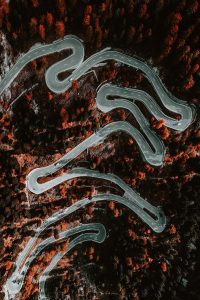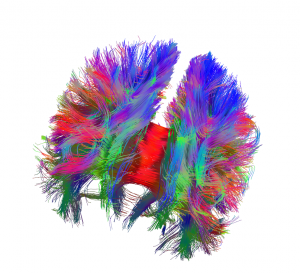We are interested in a variety of topics as they relate to navigation and the structure and acquisition of spatial knowledge.
Structure of Spatial Knowledge
Before determining how we acquire spatial knowledge, it is important to understand what exactly is being acquired. We found evidence that the underlying structure of spatial knowledge is consistent with a labeled graph, which connects locations (nodes) along paths (edges) in the environment. In contrast to pure route knowledge, we found the most frequent routes and detours had not been traveled during learning. Contrary to purely topological knowledge, navigators traveled the shortest metric distance to a goal, rather than topologically equivalent but longer paths. Thus, this topological structure of spatial knowledge connects locations without relying on a globally-consistent map-like structure, although it does include coarse local metric information.

A network composed of nodes and edges.
Selected Publications:
Chrastil, E.R., & Warren, W.H. (2015). Active and passive spatial learning in human navigation: Acquisition of graph knowledge. Journal of Experimental Psychology: Learning, Memory, & Cognition, 41(4), 1162-1178.
Chrastil, E.R., & Warren, W.H. (2014). From cognitive maps to cognitive graphs. PLOS ONE, 9(11), e112544.
Acquisition of Metric Information
If the underlying labeled graph structure of spatial knowledge includes some metric information, what is the mechanism used to acquire that local metric information?
A likely candidate is path integration, the continual updating of position and orientation during movement in an environment. We have studied path integration from a number of different angles. For example, we found evidence that navigators preferably use body-based information about self-motion to gauge distances and angles during path integration. We also found that errors in executing a desired trajectory tend to make a larger contribution in path integration errors than do errors in encoding the outbound path.
In the brain, we found activation that could support a homing vector for path integration, a process that keeps track of a navigator’s Euclidean (straight-line) distance relative to their start location during movement in a landmark-free environment. The hippocampus, retrosplenial cortex, and parahippocampal cortex had fMRI activation consistent with a homing vector. These same regions also supported memory for simple straight-line translation and rotation in place by tracking the magnitude of translation or rotation during virtual self-motion. We also have found signals important for heading direction and have uncovered functional connections between optic flow areas—which process visual information about changes in heading—and regions important for path integration, including hippocampus and retrosplenial cortex.

An experimenter running a participant through a path-integration task in VR.
Selected Publications:
Izen, S.*, Chrastil, E.R.*, & Stern, C.E. (2018). Resting state connectivity between medial temporal lobe regions and intrinsic cortical networks predicts performance in a path integration task. Frontiers in Human Neuroscience 12, 415. *denotes equal authorship
Chrastil, E. R., Sherrill, K.R., Aselcioglu, I., Hasselmo, M.E., & Stern, C.E. (2017). Individual differences in human path integration abilities correlate with gray matter volume in retrosplenial cortex, hippocampus, and medial prefrontal cortex. eNeuro, 4(2), e0346-16.2017, 1-14.
Chrastil, E.R., & Warren, W.H. (2017). Rotational error in path integration: Encoding and execution errors in angle reproduction. Experimental Brain Research, 235, 1885-1897.
Chrastil, E. R., Sherrill, K.R., Hasselmo, M.E., & Stern, C.E. (2016). Which way and how far? Tracking of translation and rotation information for human path integration. Human Brain Mapping, 37, 3636-3655.
Chrastil, E. R., Sherrill, K.R., Hasselmo, M.E., & Stern, C.E. (2015). There and back again: Hippocampus and retrosplenial cortex track homing distance in human path integration. Journal of Neuroscience, 35(46), 15442-15452.
Sherrill, K.R., Chrastil, E.R., Ross, R.S., Erdem, U.M., Hasselmo, M.E., & Stern, C.E. (2015). Functional connections between optic flow areas and navigationally responsive brain regions during goal-directed navigation. NeuroImage, 118, 386-396.
Chrastil, E.R., & Warren, W.H. (2014). Is path integration based on an intrinsic metric or absolute distance? Attention, Perception, and Psychophysics, 76(1), 230-246.
In Prep:
Chrastil, E. R., Nicora, G.L., & Huang, A. (in preparation). Vision and body-based cues make equal contributions to path integration in a novel homing task.
Chrastil, E.R., & Warren, W.H. (in preparation). Testing the error-encoding model of path integration in a triangle completion task.
Chrastil, E.R., & Warren, W.H. (in preparation). Testing model of path integration in a multi-segment homing task.
Individual Differences in Navigation
There are large individual differences in the ability to navigate as well as the acquisition of spatial knowledge. Because navigation is a relatively complex process involving many brain areas and systems, it is still unclear how these systems interact to create the process of navigation. Understanding how these processes contribute to individual differences in navigation opens up the potential for navigational training paradigms for those with navigational deficits.

Time lapse of individuals navigating through a city.
Selected Publications:
Sherrill, K.R., Chrastil, E.R., Aselcioglu, I., Hasselmo, M.E., & Stern, C.E. (2018). Structural differences in hippocampal and entorhinal gray matter volume support individual differences in first-person navigational ability. Neuroscience 380, 123-131.
Chrastil, E. R., Sherrill, K.R., Aselcioglu, I., Hasselmo, M.E., & Stern, C.E. (2017). Individual differences in human path integration abilities correlate with gray matter volume in retrosplenial cortex, hippocampus, and medial prefrontal cortex. eNeuro, 4(2), e0346-16.2017, 1-14.
In Prep:
Chrastil, E. R., Sherrill, K.R., Aselcioglu, I., & Stern, C.E. (in preparation). Gray matter volume corresponds to human navigational and video game abilities.
Cheng, Y., Hegarty, M., & Chrastil, E. R. (in preparation). Telling right from right: The influence of handedness in the mental rotation of hands.
Navigational Learning
When exploring a new city, a person might learn very different things when walking around on their own compared to being driven in a taxi. Several components contribute to active navigation, including:
- motor efference
- proprioception
- vestibular input
- allocation of attention
- cognitive decision-making
To examine how these factors contribute to spatial learning, we developed the exploration-specific learning hypothesis, which posits that these factors of active learning have different effects depending on the type of spatial knowledge that is to be acquired.
We tested this hypothesis in an immersive maze environment, finding that making decisions about exploration contributed to learning the topological graph structure of the maze. In contrast, decision-making had no effect on learning the metric distances and angles between locations. However, body-based information did contribute to this metric survey knowledge. These results indicate a sharp contrast between factors of active learning and their contribution to resulting spatial knowledge. With collaborators, we found that active exploration can assist blind navigators learn novel environments by allowing them to use spatial information more flexibly.

A young boy attempts to discern information from a map.
Selected Publications:
Chrastil, E.R., & Warren, W.H. (2015). Active and passive spatial learning in human navigation: Acquisition of graph knowledge. Journal of Experimental Psychology: Learning, Memory, & Cognition, 41(4), 1162-1178.
Connors, E.C., Chrastil, E.R., Sanchez, J., & Merebet, L.B. (2014). Virtual environments for the transfer of navigation skills in the blind: A comparison of directed instruction vs. video game based learning approaches. Frontiers in Human Neuroscience, 8, Article 223, 1-13.
Connors, E.C., Chrastil, E.R., Sanchez, J., & Merebet, L.B. (2014). Action video game play and transfer of navigation and spatial cognition skills in early blind adolescents. Frontiers in Human Neuroscience, 8, Article 133, 1-8.
Chrastil, E.R., & Warren, W.H. (2013). Active and passive spatial learning in human navigation: Acquisition of survey knowledge. Journal of Experimental Psychology: Learning, Memory, and Cognition, 39(5), 1520-1537.
Chrastil, E. R., & Warren, W. H. (2012). Active and passive contributions to spatial learning. Psychonomic Bulletin & Review, 19, 1-23.
Other Areas of Interest
Our lab is branching out to examine topics such as functional connectivity in the retrosplenial cortex as well as navigation as an early predictor of degenerative and other cognitive disorders. Additionally, we are exploring sex differences in human navigation, as well as aging.
Selected Publications:
Chrastil, E. R.*, Tobyne, S. M.*, Nauer, R. K., Chang, A. E., & Stern, C.E. (2018). Converging meta-analytic and connectomic evidence for functional sub-regions within the human retrosplenial region. Behavioral Neuroscience 132, 339-355. *denotes equal authorship
Chrastil, E.R. (2018). Heterogeneity in human retrosplenial cortex: A review of function and connectivity. Behavioral Neuroscience 132, 317-338.
Chrastil, E. R., Sherrill, K.R., Aselcioglu, I., Hasselmo, M.E., & Stern, C.E. (2017). Individual differences in human path integration abilities correlate with gray matter volume in retrosplenial cortex, hippocampus, and medial prefrontal cortex. eNeuro, 4(2), e0346-16.2017, 1-14.
Chrastil, E. R., Sherrill, K.R., Hasselmo, M.E., & Stern, C.E. (2015). There and back again: Hippocampus and retrosplenial cortex track homing distance in human path integration. Journal of Neuroscience, 35(46), 15442-15452.

